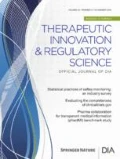Abstract
Credibility—the believability of new findings in the light of current knowledge—is a key issue in the assessment of clinical trial outcomes. Yet, despite the growth of evidence-based medicine, credibility is usually dealt with in a broad-brush and qualitative fashion. This paper describes how Bayesian methods lead to quantitative credibility assessments that take explicit account of prior insights and experience. A simple technique based on the concept of the critical prior interval (CPI) is presented, which allows rapid credibility assessment of trial outcomes reported in the standard format of odds ratios and 95% confidence intervals. The critical prior interval is easily determined via a graph, and provides clinicians with an explicit and objective baseline on which to base their assessment of credibility. The use of the critical prior interval is demonstrated through several working examples.
Similar content being viewed by others
References
Egger M, Schneider M, Davey Smith G. Meta-analysis: Spurious precision? Br Med J. 1998:316:140–144.
Freedman D, Pisani R, Purves R, Statistics. (3rd Ed) New York, NY: Norton; 1998: Chapter 29.
O’Hagan A. Kendall’s Advanced Theory of Statistics. Vol 2B: Bayesian Inference. London: Arnold; 1994.
Lilford RJ, Braunholtz D. The statistical basis of public policy: a paradigm shift is overdue. Br Med J. 1996;313:603–607.
Spiegelhalter DJ, Myles JP, Jones DR, Abrams KR. An introduction to Bayesian methods in health technology assessment. Br Med J. 319:508-512
Matthews RAJ. Facts versus Factions: the use and abuse of subjectivity in scientific research. Cambridge: European Science and Environment Forum; 1998. Reprinted in Rethinking Risk and the Precautionary Principle. Morris, J, Ed. Oxford: Butter-worth; 2000: 247-282. Available online at: http://ourworld.compuserve.com/homepages/rajm/openesef. htm.
Matthews RAJ. Why should clinicians care about Bayesian methods? J Stat Inf Plan. 2001;94:43–58. See also discussion, 59-71.
Pocock SJ, Spiegelhalter DJ. Letter (untitled). Br Med J. 1992;305:1015.
GREAT Group. Feasibility, safety and efficacy of domiciliary thrombolysis by general practitioners: Grampian region early anistreplase trial. Br Med J. 1992;305:548.
Morrison LJ, Verbeek R, McDonald AC, Sawadsky BV, Cook DJ. Mortality and prehospital thrombolysis for acute myocardial infarction: a meta-analysis. JAMA. 2000;283:2686–2692.
The Subcutaneous Sumatriptan International Study Group. Treatment of migraine attacks with sumatriptan. N Engl J Med. 1991;325:316–321.
Roberto Latini R, et al. Clinical effects of early angiotensin-converting enzyme inhibitor treatment for acute myocardial infarction are similar in the presence and absence of aspirin: Systematic over-view of individual data from 96,712 randomized patients. J Am Coll Cardio. 2000;35:1801–1807.
Egger M, Davey Smith G, Schneider M, Minder CE. Bias in meta-analysis detected by a simple graphical test. Br Med J. 1997;315:629–634.
Lee PM. Bayesian Statistics: An Introduction. 2nd Ed. London: Arnold; 1997.
Good U. Probability and the Weighing of Evidence. London: Griffin; 1950.
Author information
Authors and Affiliations
Corresponding author
Additional information
Based on a presentation from the DIA Workshop “Statistical Methodology in Clinical R&D,” April 2–4, 2001, Vienna, Austria.
Rights and permissions
About this article
Cite this article
Matthews, R.A.J. Methods for Assessing the Credibility of Clinical Trial Outcomes. Ther Innov Regul Sci 35, 1469–1478 (2001). https://doi.org/10.1177/009286150103500442
Published:
Issue Date:
DOI: https://doi.org/10.1177/009286150103500442




